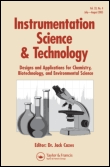
INSTRUMENTATION SCIENCE & TECHNOLOGY
Scope & Guideline
Elevating Standards in Chemical Engineering and Environmental Science
Introduction
Aims and Scopes
- Instrumentation Development:
The journal publishes research on the design and fabrication of new instruments and sensors, including optical, electrochemical, and mechanical devices, aimed at improving measurement precision and accuracy. - Analytical Techniques:
A significant focus is on novel analytical methods, such as spectroscopy, chromatography, and imaging techniques, that enhance the detection and quantification of various substances in complex matrices. - Data Acquisition and Processing:
The journal addresses advancements in data acquisition systems, signal processing algorithms, and machine learning applications that facilitate real-time data analysis and interpretation. - Environmental Monitoring:
Research pertaining to the development of sensors and instrumentation for environmental monitoring, including air quality, water quality, and climate studies, is a prominent theme. - Biomedical Applications:
The journal highlights innovations in instrumentation for biomedical applications, including diagnostics, drug delivery systems, and health monitoring technologies. - Material Characterization:
Papers often cover techniques for characterizing materials at micro and nano scales, utilizing advanced methods such as X-ray scattering, electron microscopy, and spectrophotometry.
Trending and Emerging
- Machine Learning and AI Integration:
There is a growing interest in incorporating machine learning and artificial intelligence techniques into instrumentation, enhancing data analysis capabilities and enabling predictive modeling. - Sustainable and Green Technologies:
Research focusing on sustainable instrumentation solutions and green analytical methods is on the rise, reflecting the global emphasis on environmental responsibility. - Miniaturized and Portable Devices:
The development of compact and portable instrumentation for field applications is trending, allowing for on-site measurements and real-time data acquisition. - Optical and Photonic Sensors:
The emergence of advanced optical sensing technologies, including fiber optics and photonics, is a significant trend, driven by their high sensitivity and versatility in various applications. - Wearable and Implantable Sensors:
Innovations in wearable and implantable sensor technologies for health monitoring and diagnostics are gaining attention, catering to the growing demand for personal health management. - Multifunctional and Multimodal Sensors:
There is an increasing focus on multifunctional sensors capable of measuring multiple parameters simultaneously, providing comprehensive data for complex analyses.
Declining or Waning
- Traditional Analytical Chemistry Techniques:
There has been a noticeable decline in publications focused on conventional analytical methods such as titrations and basic spectroscopic techniques, as researchers gravitate towards more sophisticated and automated systems. - Static Measurement Systems:
Research on static or less dynamic measurement systems is decreasing, with a shift towards more flexible, real-time, and automated instrumentation solutions. - Basic Sensor Technologies:
Papers on basic sensor technologies without integration of advanced materials or methodologies are becoming less frequent, reflecting a trend towards more complex and multifunctional sensor designs. - Non-automated Laboratory Procedures:
As automation and smart laboratory solutions gain traction, traditional manual laboratory procedures and setups are being published less frequently. - Single-Use and Disposable Devices:
The focus on single-use devices in instrumentation is waning as researchers are now prioritizing sustainable and reusable technologies that minimize waste.
Similar Journals
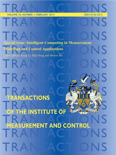
TRANSACTIONS OF THE INSTITUTE OF MEASUREMENT AND CONTROL
Empowering Innovation through Measurement ExcellenceTRANSACTIONS OF THE INSTITUTE OF MEASUREMENT AND CONTROL, published by SAGE Publications Ltd, is a prestigious journal that has been at the forefront of research in measurement and control since its inception in 1979. With its ISSN 0142-3312 and E-ISSN 1477-0369, this UK-based journal is indexed in reputable databases, showcasing its impact in the field, highlighted by a notable Q2 ranking in Instrumentation for 2023. The journal serves as a vital platform for scholars and practitioners alike, publishing high-quality, peer-reviewed articles that span a range of topics related to measurement technology and control systems. With an increasing focus on interdisciplinary approaches, TRANSACTIONS OF THE INSTITUTE OF MEASUREMENT AND CONTROL strives to advance the understanding and application of innovative measurement and control methodologies, making it an essential resource for academics, industry professionals, and students aiming to enhance their knowledge and expertise in this dynamic field. Although it operates under a traditional subscription model, the journal's commitment to disseminating cutting-edge research remains unwavering, inviting contributions that push the boundaries of instrumentation and control science.
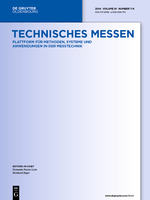
tm-Technisches Messen
Fostering Collaboration in Engineering Excellencetm-Technisches Messen is a reputable academic journal published by WALTER DE GRUYTER GMBH, focusing on the field of engineering, specifically in Electrical and Electronic Engineering and Instrumentation. With a rich history dating back to 1931, this journal serves as a critical platform for disseminating research, innovations, and developments relevant to measurement and instrumentation technologies. Despite its current quartile rankings of Q3 in Electrical and Electronic Engineering and Q4 in Instrumentation for 2023, the journal continues to attract submissions from leading researchers, offering insights that drive advancements within these fields. Researchers and practitioners can access a wealth of knowledge through this publication, fostering collaboration and sparking new ideas. Located in Berlin, Germany, the journal operates without an open-access model, making it essential for universities and institutions to play an integral role in supporting their library access to this valuable resource. As the journal continues to evolve through 2024 and beyond, it remains a significant contributor to the global discourse in measurement technologies, making it a must-read for anyone involved in these dynamic areas of study.

Geoscientific Instrumentation Methods and Data Systems
Exploring the Depths of Geoscience through Open Access InnovationGeoscientific Instrumentation Methods and Data Systems, published by COPERNICUS GESELLSCHAFT MBH, is a distinguished open-access journal dedicated to the dissemination of innovative methodologies, advanced instrumentation, and comprehensive data systems in the earth sciences. With an ISSN of 2193-0856 and an E-ISSN of 2193-0864, this journal has been paving the way for insightful research since its inception in 2012. Based in Germany, it serves a global audience interested in atmospheric science, geology, and oceanography, reflected in its impressive Scopus rankings and recent categorizations as Q2 and Q3 in these vital fields. The journal’s mission is to foster interdisciplinary collaboration and facilitate knowledge exchange, providing a platform for researchers and professionals to share significant advancements and challenge the frontiers of geoscientific instrumentation and methods. As an open-access journal, it ensures that pivotal research findings are accessible to a wider audience, promoting inclusivity and rapid dissemination of knowledge critical to addressing global challenges in earth and planetary sciences.

ULTRASONICS
Exploring Innovations in Acoustics and BeyondULTRASONICS is a premier international journal published by Elsevier that has been a cornerstone of research in the field of acoustics and ultrasonics since its inception in 1963. With an impressive impact factor, it stands prominently in the Q1 category (2023) of Acoustics and Ultrasonics, ranked 6th out of 44 in Physics and Astronomy, placing it in the top 13% of its field. This journal offers a comprehensive platform for the dissemination of innovative research, ranging from theoretical studies to practical applications. Researchers, professionals, and students are encouraged to engage with cutting-edge findings that advance knowledge in ultrasonic technology, medical imaging, non-destructive testing, and other interdisciplinary applications. Although ULTRASONICS does not currently offer open access options, its rigorous peer-review process ensures high-quality, impactful publications that are essential for anyone involved in the field. Located in Amsterdam, Netherlands, the journal continues to uphold its reputation as a leading source of scientific knowledge that aims to facilitate advancements in technology and engineering.

MICROCHIMICA ACTA
Connecting Scholars Through Groundbreaking ResearchMicrochimica Acta is a prestigious journal in the field of Analytical Chemistry, published by Springer Wien. With a history spanning nearly a century, since its inception in 1926, this journal continues to play a significant role in advancing chemical research, currently ranking #18 out of 156 in its category according to Scopus, placing it within the top 88th percentile. Microchimica Acta publishes high-quality, peer-reviewed articles that cover a diverse range of topics in analytical techniques, instrumentation, and methodologies. Researchers and professionals alike benefit from its comprehensive scope, which fosters innovation and knowledge-sharing in the analytical chemistry community. Despite its non-open-access model, the journal is committed to disseminating critical findings that drive progress in academia and industry, ensuring its relevance in a continually evolving field. As an essential resource, Microchimica Acta not only contributes significantly to scholarly discourse but also provides a platform for emerging concepts and practices in the analytical landscape.

SENSORS
Illuminating the path of sensor technology evolution.SENSORS is a leading peer-reviewed open-access journal published by MDPI, dedicated to the field of sensor technology and its applications. Established in 2001 and located in Basel, Switzerland, this journal plays a pivotal role in disseminating groundbreaking research encompassing various disciplines, including Analytical Chemistry, Physics, Engineering, and Biochemistry. With a distinguished 2023 Scopus ranking that places it in Q1 across multiple categories and a commendable impact factor reflective of its high-quality contributions, SENSORS has cemented its status as an essential resource for researchers and professionals alike. The journal is committed to facilitating knowledge exchange in cutting-edge sensor technologies, fostering advancement in areas such as instrumentation, medical applications, and electronic engineering. The convenient open-access model ensures that research findings are readily accessible to a global audience, promoting collaboration and innovation within the scientific community. For all those interested in probing the depths of this dynamic field, SENSORS provides a rich repository of research that not only informs but inspires future explorations.
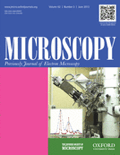
Microscopy
Illuminating the Future of Imaging and AnalysisMicroscopy, published by Oxford University Press, is a prestigious journal dedicated to advancing the field of microscopy and imaging in biological and applied sciences. With a dynamic coverage dating from 1953 to the present, it offers vital insights into the latest techniques and applications across various disciplines, including Instrumentation, Radiology, Nuclear Medicine and Imaging, and Structural Biology. The journal is recognized for its quality, illustrated by its Q2 and Q3 quartile rankings in relevant categories for 2023. Researchers, professionals, and students will find Microscopy an invaluable resource for keeping abreast of contemporary developments and methodologies in the field. As an open-access journal, it promotes equitable access to cutting-edge research and fosters collaboration among the international scientific community, making it essential reading for anyone involved in microscopy research and its applications. For more information, please visit their site for access options and contributions.
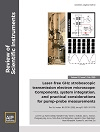
REVIEW OF SCIENTIFIC INSTRUMENTS
Your Gateway to Cutting-Edge Instrumentation InsightsWelcome to the Review of Scientific Instruments, an esteemed journal published by AIP Publishing that has been a cornerstone in the field of scientific instrumentation since its inception in 1930. With an ISSN of 0034-6748 and E-ISSN of 1089-7623, this journal serves as a vital platform for the dissemination of innovative research and advancements in both Instrumentation and Medicine, categorized in Q3 quartiles in 2023. The journal has proudly maintained its relevance, forecasting continued publication through 2024, while providing critical insights that influence contemporary practices in various scientific domains. The impact factor reflects its contribution to the academic community, making it an invaluable resource for researchers and professionals seeking to stay at the forefront of scientific progress. Although Access is not open, the rigorous peer-review process ensures that published works are of the highest quality, making the Review of Scientific Instruments a must-read for anyone involved in the intricate world of experimental science and technological innovations.

APPLIED SPECTROSCOPY
Exploring the Depths of Spectroscopic ScienceApplied Spectroscopy, published by SAGE Publications Inc, is a leading journal in the field of spectroscopy and instrumentation, with a legacy dating back to 1970. This esteemed journal, recognized within the Q2 category for both Instrumentation and Spectroscopy in 2023, provides critical insights and advancements that cater to a wide audience of researchers, professionals, and students. With its Scopus rankings placing it in the top 20% of publications in its respective fields, Applied Spectroscopy stands out for its rigorous peer-reviewed content that drives innovation in analytical techniques and applications. Though not an open-access publication, readers can access a wealth of research articles, reviews, and experimental findings that enrich the scientific discourse in spectroscopy. With a focus on enhancing the understanding and practical applications of spectroscopy, this journal is an essential resource for anyone engaged in this dynamic and evolving discipline.
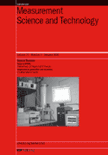
MEASUREMENT SCIENCE and TECHNOLOGY
Bridging Theory and Practice in Measurement ApplicationsMEASUREMENT SCIENCE and TECHNOLOGY is a premier journal published by IOP Publishing Ltd that delves into the critical intersection of measurement science and engineering applications. With a robust focus on innovative measurement techniques, instrumentation, and applied mathematics, this journal has established itself as a vital resource for researchers and professionals striving to advance the field. Recognized for its scholarly impact, it maintains an impressive impact factor and is categorized in the Q2 quartile across Applied Mathematics, Engineering (miscellaneous), and Instrumentation, demonstrating its significant contribution to these disciplines. The journal is indexed in prominent databases, including Scopus, where it ranks 122 out of 635 in Applied Mathematics and holds the 56th position in Engineering (miscellaneous). Spanning from 1990 to 2024, MEASUREMENT SCIENCE and TECHNOLOGY offers a wealth of rigorous peer-reviewed articles that not only support academic inquiry but also inform practical applications in measurement technology. Located in the United Kingdom, the journal serves as a collaborative platform for the global research community, inviting contributions that shape the future of measurement science.